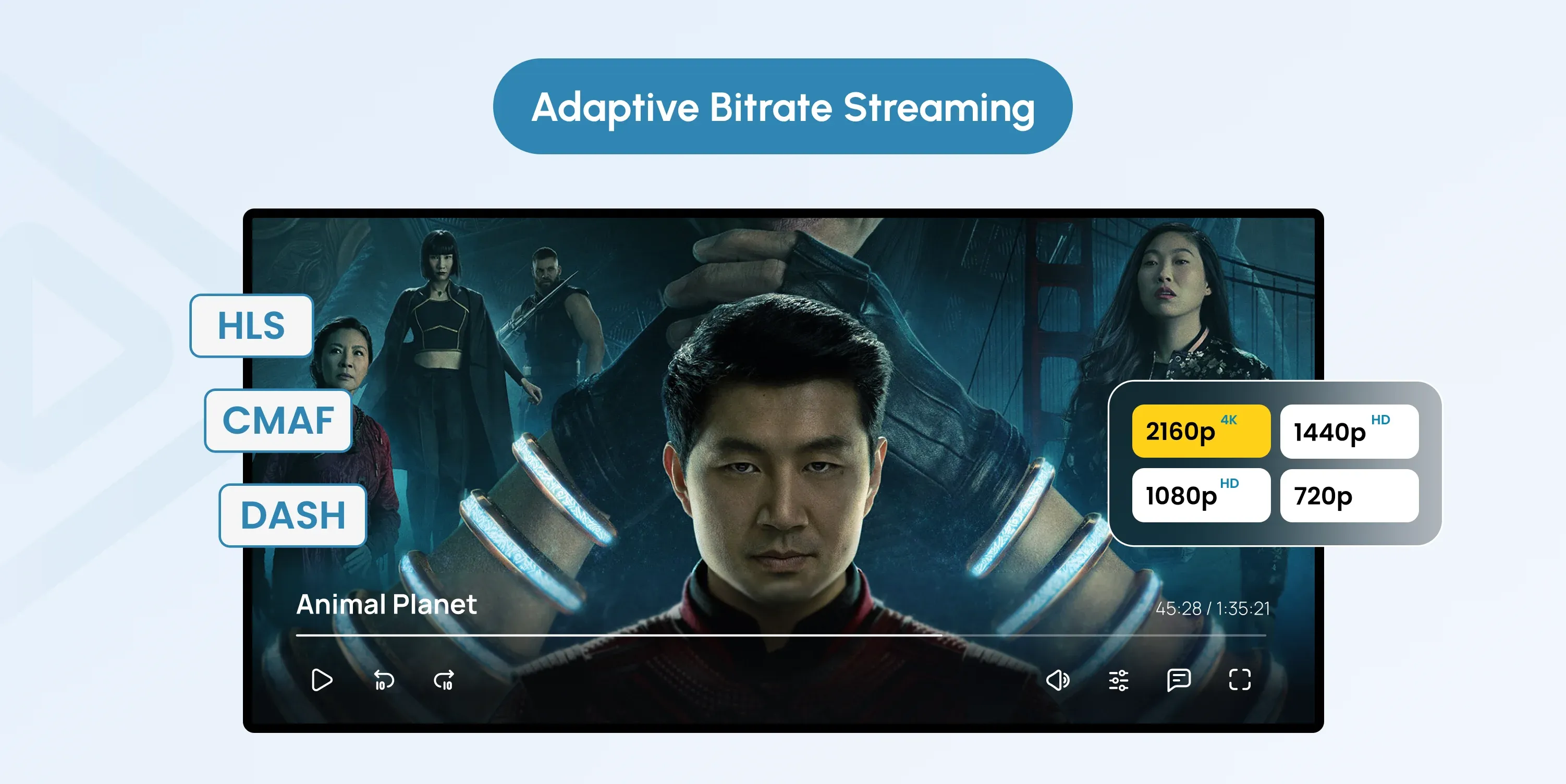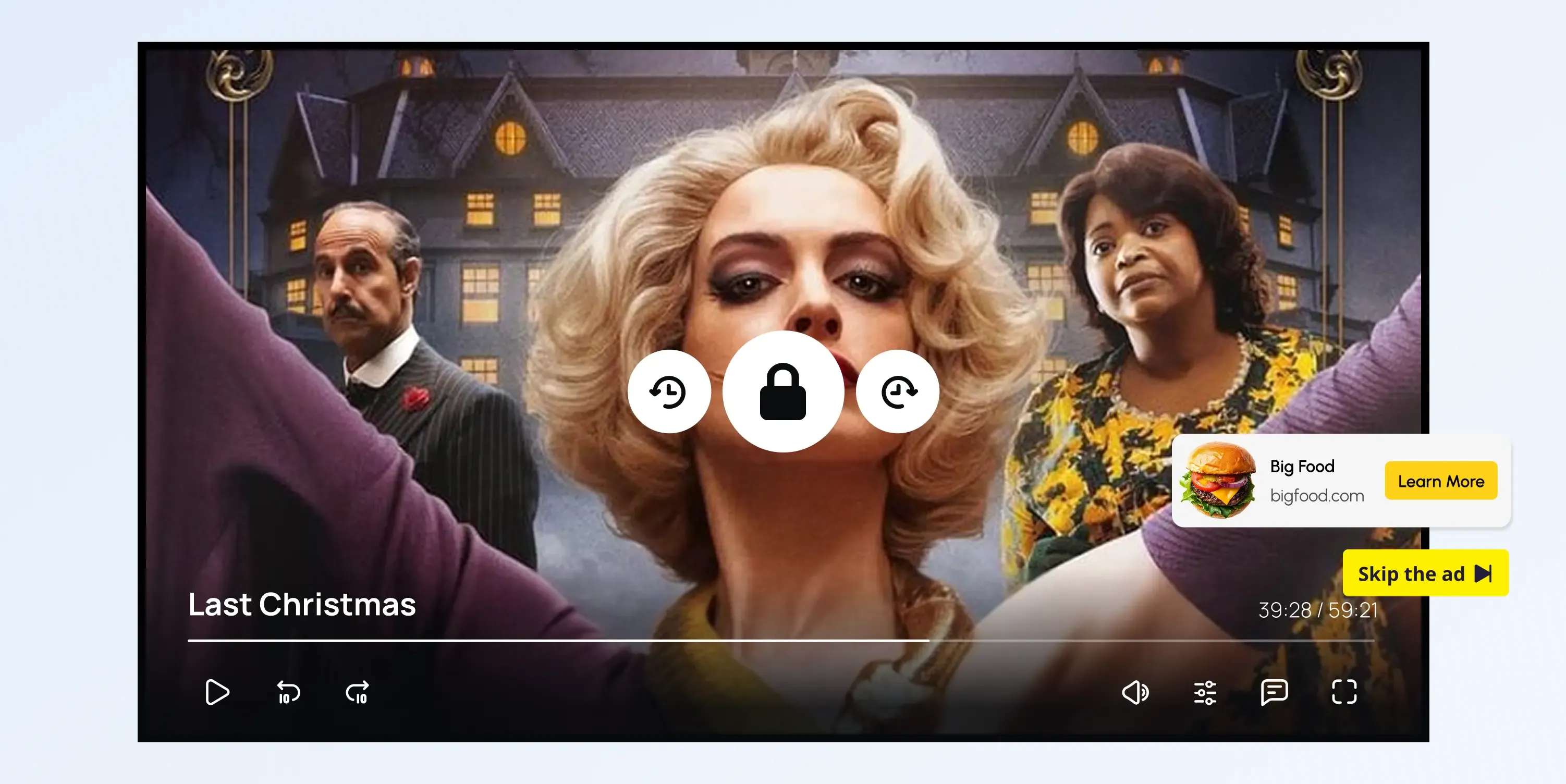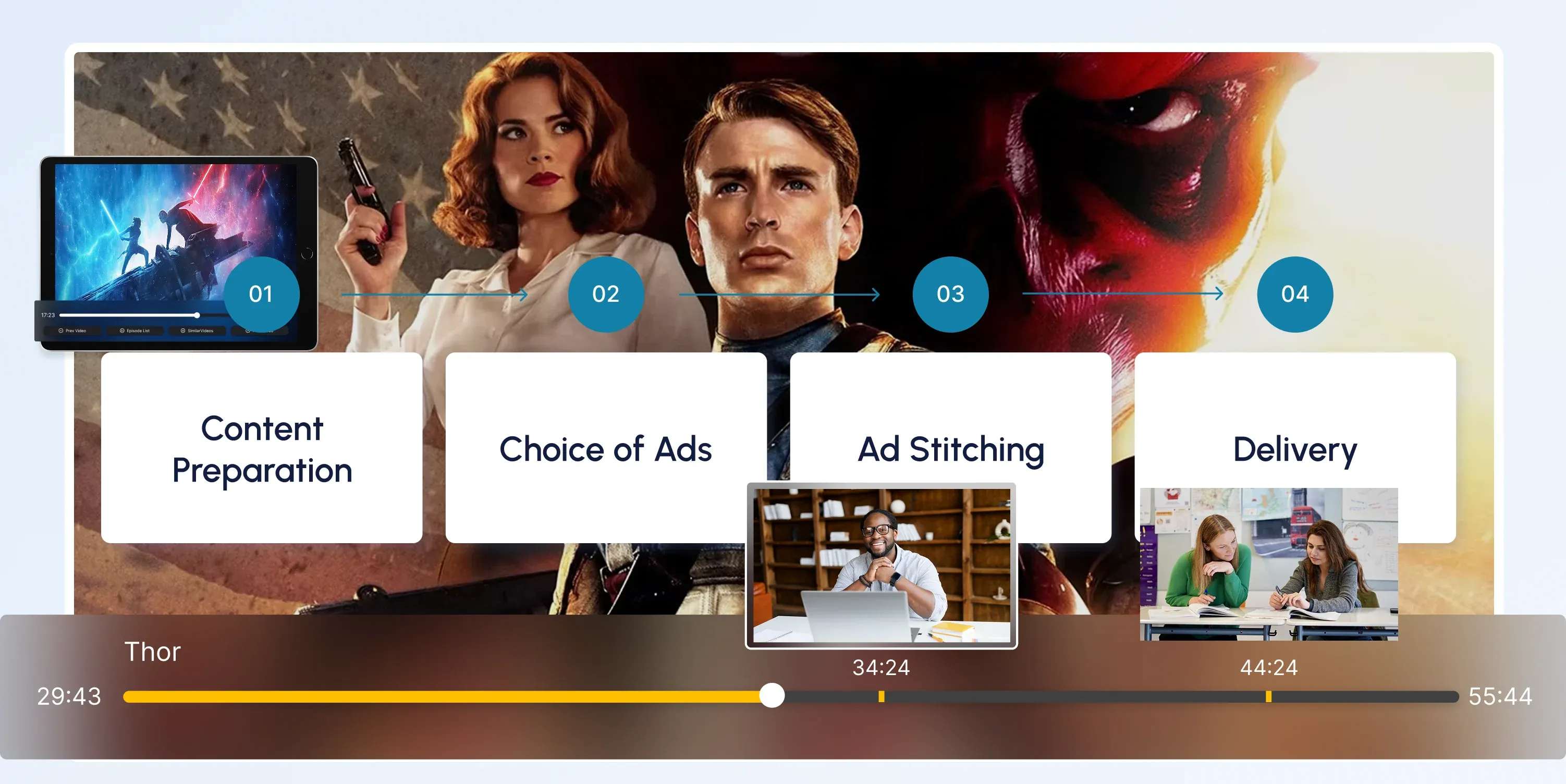Glossary term
Adaptive Bitrate Streaming (ABR)

What Is Adaptive Bitrate Streaming?
Adaptive Bitrate Streaming (ABR) is a video streaming method that automatically adjusts the quality of a video stream in real time based on the viewer’s network speed, device performance, and playback conditions.
It ensures smooth playback by switching between different bitrate versions of the video, minimizing buffering and quality drops.
What Streaming Protocols Support Adaptive Bitrate Streaming?
| Protocol | Developed By | Manifest Format | Key Features |
|---|---|---|---|
| HLS (HTTP Live Streaming) | Apple | .m3u8 (M3U) | Most widely supported, used across iOS, Android, Smart TVs, web browsers |
| MPEG-DASH (Dynamic Adaptive Streaming over HTTP) | MPEG Group | .mpd (XML) | Open standard, codec-agnostic, used by YouTube, Netflix, and many enterprise platforms |
| Microsoft Smooth Streaming | Microsoft | .ism/.ismc | Mostly legacy, used in older Microsoft environments |
| CMAF (Common Media Application Format) | Apple + MPEG | Used with HLS & DASH | Reduces latency, supports both HLS and DASH segments with a single encoding |
Note: Older protocols like RTMP and RTSP do not support ABR natively. So, ABR became mainstream with HTTP-based delivery, which is more scalable and compatible with CDNs (Content Delivery Networks) and modern devices.
Technologies Behind Adaptive Bitrate Streaming
| Technology | Purpose | Examples / Formats |
|---|---|---|
| Video Codecs | Compress video for efficient delivery with minimal quality loss | H.264 (AVC), H.265 (HEVC), AV1 |
| Segmenting Tools | Break videos into small chunks (2–10 sec) for adaptive delivery | FFmpeg, Shaka Packager |
| Streaming Protocols | Deliver video segments over HTTP with adaptive capabilities | HLS, MPEG-DASH, CMAF |
| Manifest Files | Index available video qualities and segment URLs | .m3u8 (HLS), .mpd (MPEG-DASH) |
| ABR-Enabled Video Players | Switch quality based on network, buffer, and device performance | HLS.js, Dash.js, Shaka Player, Video.js, native players (Safari, iOS) |
| Content Delivery Networks (CDNs) | Distribute video content globally for faster access | Akamai, Cloudflare, Fastly, Amazon CloudFront |
| Analytics and QoS Tools | Monitor playback performance and viewer experience | Mux, Conviva, Bitmovin Analytics |
How Adaptive Bitrate Streaming Works
Step 1. Encoding at Multiple Bitrates
The original video is compressed into multiple versions, each with a different resolution and bitrate—such as 240p, 480p, 720p, and 1080p.
This process ensures that viewers with varying internet speeds and device capabilities can stream the video at the most suitable quality. By preparing different versions in advance, the system enables real-time switching during playback for a smooth viewing experience.
Step 2. Segmenting the Video
After encoding, each version of the video is broken down into small, time-based segments—typically ranging from 2 to 10 seconds in length. These short, self-contained chunks allow the video player to switch between different quality levels as needed quickly.
By working with segments rather than a continuous stream, the system enables precise control over playback quality and helps ensure smooth, adaptive streaming across varying network conditions.
Step 3. Manifest File Generation
A manifest (index) file (a playlist or index file that tells the video player how to retrieve and play the media content) is created (e.g., .m3u8 for HLS, .mpd for MPEG-DASH).
It lists important details like available bitrates, resolutions, segment URLs, codecs, and other metadata required for adaptive bitrate streaming.
Step 4. Initial Playback Starts
When the user presses play, the video player first downloads the manifest file to understand the available video qualities and segment URLs. It then selects a low- or mid-bitrate stream to start playback quickly and reduce the risk of buffering.
This conservative starting point ensures the video begins smoothly, even on slower or unstable connections. As the player gathers more data about the network conditions, it prepares to switch to higher or lower qualities if needed.
Step 5. Network and Buffer Monitoring
As the video plays, the video player continuously checks how fast data is being downloaded (available bandwidth), how much video is already loaded and ready to play (buffer length), and how well the device is handling playback (CPU or device performance).
By monitoring these factors in real time, the player can decide whether to increase or decrease video quality to keep playback smooth without pauses or buffering.
Step 6. Bitrate Switching
Using real-time data from network and buffer monitoring, the player intelligently selects a higher or lower bitrate for the upcoming video segment. If the connection is strong and stable, it upgrades to a higher-quality stream.
If bandwidth drops or the buffer shrinks, it switches to a lower bitrate to prevent interruptions. This decision happens continuously, segment by segment, ensuring the stream adapts to changing conditions.
Step 7. Seamless Playback Continuation
The player performs quality switches between segments, not during them, which makes the transition almost invisible to the viewer. Because each segment is short and self-contained, the player can swap quality levels without causing buffering or playback jumps.
As a result, the viewer enjoys a consistent and uninterrupted streaming experience, even as conditions change.
Related processes involved in Adaptive Bitrate Streaming
1. Encoding
Encoding is the process of converting raw video into compressed digital formats suitable for streaming. For ABR, the video is encoded multiple times at different bitrates, resolutions, and sometimes framerates.
For example, a single video might be encoded into:
- 240p at 400 Kbps
- 480p at 1 Mbps
- 720p at 2.5 Mbps
- 1080p at 5 Mbps
- 4K at 10+ Mbps
Each version balances quality and bandwidth requirements, allowing the player to switch depending on real-time conditions.
2. Segmenting (Chunking the Video)
After encoding, each version of the video is split into small time-based segments (chunks), usually between 2 to 10 seconds long. These segments are saved as separate files. This allows the player to mix and match different bitrate segments seamlessly.
For example, the player might start with 480p segments, then switch to 720p if network conditions improve.
3. Packaging (Manifest Creation)
Packaging involves creating a manifest file that lists all available video qualities and the URLs of each segment. The manifest is the "playlist" the player uses to request video data. Examples:
- HLS: uses .m3u8 manifest format.
- MPEG-DASH: uses .mpd (Media Presentation Description) format.
These files include metadata about bitrates, resolutions, codecs, and segment duration.
4. Player Logic (Adaptive Bitrate Algorithm)
The ABR algorithm within the video player reads the manifest file, measures current network speed, and decides which bitrate to load for each segment.
The logic takes into account:
- Current and average network bandwidth
- Playback buffer length
- Device CPU/GPU performance
- Past download success or failure
The algorithm dynamically adjusts the quality by selecting higher or lower bitrate segments for smooth, uninterrupted playback.
5. CDN Delivery (Content Delivery Network)
A CDN ensures that all video segments at all quality levels are stored on multiple servers across different geographic locations. When a viewer requests playback, the nearest CDN edge server delivers the video chunks, reducing latency and load times.
CDNs make adaptive bitrate scalable and resilient, even during peak traffic.
6. Buffer Management
The video player maintains a buffer - a temporary memory area where segments are preloaded before playback. Effective buffer management allows the player to preload enough content to prevent interruptions without overloading memory.
The ABR algorithm also considers buffer fullness to avoid aggressive bitrate changes that could cause playback stalling.
7. Metrics Reporting
During playback, the player collects data such as:
- Segment download times
- Bitrate switching events
- Buffer underruns
- Playback errors
This information helps improve future streaming sessions and is often sent to analytics platforms or streaming backends for quality-of-service monitoring and optimization.
Adaptive Bitrate vs Progressive Download
What is Progressive Download? It is a basic method where the video file is downloaded from a web server and starts playing once enough of it has been buffered, but it doesn’t adjust the quality during playback.
Compared to adaptive bitrate streaming, progressive download offers less flexibility, no quality switching, and can cause buffering on slow connections.
Here is a full comparison of ABR and progressive download:
| Feature | Adaptive Bitrate (ABR) Streaming | Progressive Download |
|---|---|---|
| Quality Switching | Yes, dynamically during playback | No, fixed quality only |
| Segmented Playback | Yes, video is split into short chunks | No, the entire file is downloaded linearly |
| Buffer Management | Actively managed by the player | Passive; buffer fills as data arrives |
| Network Adaptability | Adapts to real-time bandwidth changes | No adaptation |
| Streaming Protocols | HLS, MPEG-DASH, CMAF | Standard HTTP |
| Initial Playback Speed | Starts quickly with a low bitrate | Slightly slower start due to buffering |
| Use Case | Modern platforms (Netflix, YouTube) | Simple video hosting (e.g., blogs) |
| Bandwidth Efficiency | High; avoids overloading the network | Low; may waste bandwidth on unused data |
| File Storage | Segments not stored locally | Often saved in browser cache |
ABR Streaming is best for:
- Smooth playback across different network conditions.
- Building a modern video platform with user experience in mind.
- Supporting multiple devices and resolutions.
Progressive Download is best for:
- Short videos or simple web embeds.
- When there’s no need to support multiple quality levels.
- Stable and predictable network conditions.
What are Benefits of Adaptive Bitrate Streaming?
This section highlights the advantages of ABR, but it also sums up everything about adaptive bitrate streaming. So, this is your conclusion on what adaptive streaming does.
Smooth Playback
ABR dynamically adjusts video quality based on real-time conditions. If a viewer's network slows down, the player automatically switches to a lower bitrate stream to avoid buffering. When conditions improve, it seamlessly returns to a higher quality, so the video keeps playing without interruptions.
Optimized for Any Network Environment
Whether it’s high-speed broadband, mobile data, or inconsistent Wi-Fi, ABR intelligently selects the most suitable quality level based on the available bandwidth. In other words, adaptive bitrate streaming delivers the best possible experience regardless of the connection quality.
Broad Device Compatibility
Since ABR streaming typically uses HTTP-based protocols like HLS or MPEG-DASH, it works across desktops, smartphones, smart TVs, and tablets. It doesn’t need special plugins or players.
Efficient Bandwidth Usage
Adaptive bitrate avoids sending high-bitrate streams when unnecessary, which reduces data consumption and delivery costs. This is especially beneficial for mobile users or those on metered connections.
Faster Start Times
Instead of waiting for a high-resolution stream to buffer, ABR starts with a lower bitrate version that loads quickly, allowing playback to begin almost immediately.
Seamless Quality Switching
Adaptive bitrate enables quality switching between video segments. These transitions are virtually invisible to the viewer, maintaining consistent playback even as quality levels change.
Scalability and Cost-effectiveness
It works with standard HTTP servers and CDNs, making it easy to deliver content to millions of users without the need for dedicated streaming infrastructure. Overall, adaptive bitrate streaming greatly enhances the user experience; it keeps viewers engaged by adapting to their real-time needs.
Frequently Asked Questions
Content Writer
Anush Sargsyan is a content writer specializing in B2B content about OTT streaming technologies and digital media innovation. She creates informative, engaging content on video delivery, OTT monetization, and modern media technologies. The goal is to help readers easily understand complex ideas. Her writing is the bridge between technical detail and practical insight, making advanced concepts accessible for both industry professionals and general audiences.
Related terms

AVOD (Advertising-Based Video on Demand)
Explore how AVOD works, its monetization model, and why it's popular for free streaming platforms. Read the full definition on inorain.com glossary.

CSAI (Client-Side Ad Insertion)
Learn how CSAI delivers ads through the video player, enabling targeting, tracking, and monetization.

